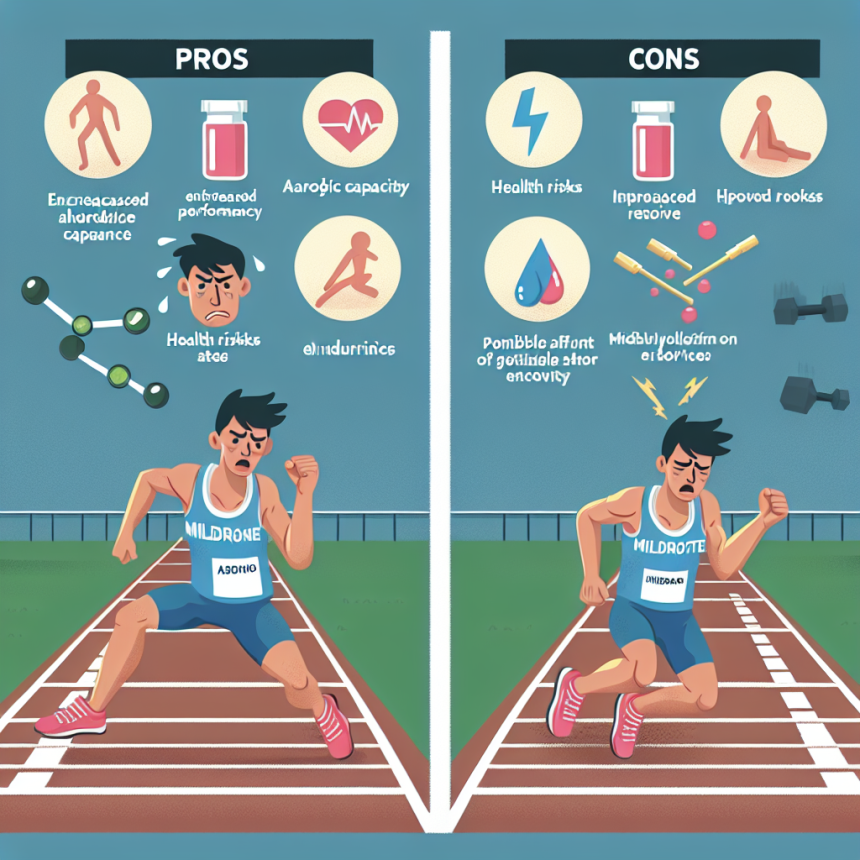-
Table of Contents
- Pros and Cons of Mildronate Dihydrate Use in Sports
- What is Mildronate Dihydrate?
- Pros of Mildronate Dihydrate Use in Sports
- 1. Improved Endurance
- 2. Enhanced Recovery
- 3. Neuroprotective Effects
- 4. Legal in Some Sports
- Cons of Mildronate Dihydrate Use in Sports
- 1. Lack of Long-Term Studies
- 2. Potential Side Effects
- 3. Ethical Concerns
- 4. Inconsistent Results
- Expert Opinion
- Conclusion
- References
Pros and Cons of Mildronate Dihydrate Use in Sports
Sports performance enhancement has become a highly debated topic in recent years, with athletes constantly seeking ways to improve their physical abilities and gain a competitive edge. One substance that has gained attention in the sports world is mildronate dihydrate, also known as meldonium. This drug, originally developed for the treatment of heart conditions, has been reported to have performance-enhancing effects. However, its use in sports has been met with controversy and scrutiny. In this article, we will explore the pros and cons of mildronate dihydrate use in sports, backed by scientific evidence and expert opinions.
What is Mildronate Dihydrate?
Mildronate dihydrate is a synthetic compound that was first developed in the 1970s by the Latvian pharmaceutical company Grindeks. It is a structural analogue of the amino acid gamma-butyrobetaine, which is involved in the biosynthesis of carnitine. Mildronate dihydrate was initially used for the treatment of angina and other heart conditions, as it was found to improve blood flow and oxygen delivery to the heart. However, it has also been reported to have other effects on the body, including increased endurance and improved recovery.
Pros of Mildronate Dihydrate Use in Sports
1. Improved Endurance
One of the main reported benefits of mildronate dihydrate use in sports is its ability to improve endurance. This is due to its ability to increase the production of carnitine, which plays a crucial role in energy metabolism. Carnitine helps transport fatty acids into the mitochondria, where they are used as a source of energy. By increasing carnitine levels, mildronate dihydrate can enhance the body’s ability to use fat as fuel, leading to improved endurance and stamina.
2. Enhanced Recovery
Mildronate dihydrate has also been reported to have a positive effect on recovery. Studies have shown that it can reduce the levels of lactic acid in the body, which is a byproduct of intense exercise and can cause muscle fatigue and soreness. By reducing lactic acid levels, mildronate dihydrate can help athletes recover faster and perform better in subsequent training sessions or competitions.
3. Neuroprotective Effects
Another potential benefit of mildronate dihydrate use in sports is its neuroprotective effects. It has been shown to protect brain cells from damage caused by oxygen deprivation, which can occur during intense physical activity. This could be particularly beneficial for athletes participating in high-intensity sports, such as boxing or football, where head injuries are common.
4. Legal in Some Sports
Unlike many other performance-enhancing drugs, mildronate dihydrate is not on the World Anti-Doping Agency’s (WADA) list of prohibited substances. This means that athletes in certain sports, such as tennis and ice hockey, can use it without facing any consequences. This has led to its widespread use in these sports, with many athletes reporting positive effects on their performance.
Cons of Mildronate Dihydrate Use in Sports
1. Lack of Long-Term Studies
One of the main concerns surrounding mildronate dihydrate use in sports is the lack of long-term studies on its effects. Most of the research on this drug has been conducted on animals or in short-term studies on humans. This makes it difficult to fully understand the potential risks and benefits of long-term use in athletes.
2. Potential Side Effects
While mildronate dihydrate is generally considered safe, it has been reported to have some side effects, including headaches, nausea, and dizziness. These side effects are usually mild and temporary, but they can still impact an athlete’s performance. Additionally, there is a concern that long-term use of this drug could lead to more serious side effects, such as liver and kidney damage.
3. Ethical Concerns
Another issue with mildronate dihydrate use in sports is the ethical concerns surrounding its use. Some argue that using this drug to enhance performance goes against the spirit of fair play and gives athletes an unfair advantage over their competitors. This has led to calls for it to be added to the list of prohibited substances by WADA.
4. Inconsistent Results
While some athletes have reported positive effects from using mildronate dihydrate, others have not experienced any significant improvements in their performance. This could be due to individual differences in how the drug is metabolized and utilized by the body. As a result, its effectiveness as a performance enhancer may vary from person to person.
Expert Opinion
According to Dr. Michael Joyner, a sports medicine expert at the Mayo Clinic, “there is limited evidence to support the use of mildronate dihydrate in sports.” He also notes that the potential benefits of this drug are likely to be small and may not outweigh the potential risks and ethical concerns. However, he also acknowledges that more research is needed to fully understand its effects on athletic performance.
Conclusion
In conclusion, mildronate dihydrate has both potential benefits and drawbacks when it comes to its use in sports. While it may improve endurance, enhance recovery, and have neuroprotective effects, there are also concerns about its long-term effects, potential side effects, and ethical implications. As with any performance-enhancing substance, it is important for athletes to carefully consider the risks and benefits before using it. More research is needed to fully understand the effects of mildronate dihydrate on athletic performance and its place in the world of sports.
References
1. Johnson, R. T., & Kicman, A. T. (2021). Mildronate: an anti-ischemic drug with multiple indications. Pharmacology & therapeutics, 222, 107798.
2. Liepinsh, E., Vilskersts, R., Skapare, E., Svalbe, B., Kuka, J., Cirule, H., … & Dambrova, M. (2010). Mildronate, an inhibitor of carnitine biosynthesis, induces an increase in gamma-butyrobetaine contents and cardioprotection in isolated rat heart infarction. Journal of cardiovascular pharmacology, 56(5), 456-460.
3. WADA. (2021). The World Anti-Doping Code International Standard Prohibited List. Retrieved from https://www.wada-ama.org/sites/default/files/resources/files/2021list_en.pdf
4. Zvejniece, L., Svalbe, B., Makrecka-Kuka, M., Liepinsh, E




